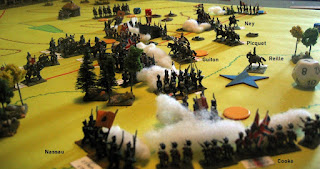Another story from my father-in-law about his time in Korea. Keep ’em coming, says I. all in his own words. My notes are in italic.
The recoilless rifle works by allowing the
blast gasses to escape out the rear to offset the kick when it is fired. When fired,
the back blast can be deadly. The gunner sat on the left with the telescopic
sight. The loading crew of two or three sat on the right of the barrel. The barrel
was normally a four-man carry. It sat on a .30 Cal. heavy machine gun tripod. The
gun was developed at the end of WWII and used extensively during the Korean
War. The weapons platoon of the rifle companies had them in 57mm. My Battalion
Heavy Weapons Company had the 75mm. as I was leaving Korea these were replaced
with 105mm guns, jeep mounted. The recoilless rifle was a high velocity, low
trajectory, direct or indirect fire type of artillery piece.
It had
three shells:
HE
(High Explosive) with a fuse that could be set at “Super Quick”, or “Delay”. With
Delay it could penetrate a bunker and explode inside. A good gunner could skip
a round off the frozen ground and get an air burst on the reverse slope of a
hill or a detonation back in a cave. We used this shell most of the time.
HEAT
(High Explosive Anti-Tank) that used a shaped charge designed to penetrate
armor at close range. The round was not very effective against the Russian T-34
medium tanks being supplied to North Korea and China.
WP
(White Phosphorous) used to mark distant shell hits while other artillery
shells were landing in the same vicinity. The gunner could find his splash and
adjust his aim from there to his target. A good gunner could be on target with
two or three rounds. It was also used on concentrated troops and to set targets
on fire.
The 21.8
pound HE projectile had a max range of 7,000 yards, nearly 4 miles but the
effective range was about 2 miles especially in high Korean cross winds.
We also
had prearranged concentrations so our infantry patrols could call in our fire
support at night if needed. More often they called for the 105mm and 155mm howitzers
a mile behind the front line which could fire barrages.
This
type of weapon served its purpose in trench fighting like during the Korean War
while I was there. As you know it has since been made obsolete by guided tank
and artillery shells. It can now be seen only in military museums.
Note:
I was surprised to find the HEAT round had trouble with the T-34. I knew that
the 2.36” bazooka issued to our infantry at the start of the war couldn’t
penetrate the front glacis armor of the T-34/85 (or the Chinese copy, the Type
85). Later the “super Bazooka”, 3.5” was issued and that could defeat the T-34
armor.



















